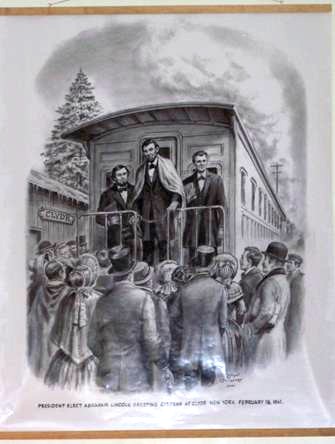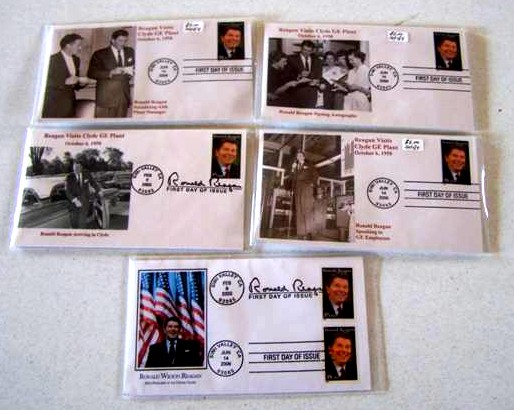|
Tales, Trivia and Poetry
Did You Know?
-
The Galen Historical Society celebrated its 40th year in 2016.
-
Amelia Jenks Bloomer, famous for wearing the costume that bears her name, was qualified to teach and at age 17 taught school in Clyde.
-
The first female Village Mayor in New York State was elected in Clyde.
Mayor Katherine M. Wykle elected March of 1937 and again March of 1941. She was the first women elected to head ANY village government in New York State
-
Two American Presidents visited Clyde.
President Elect Abraham Lincoln’s stop is well documented and the funeral train taking his body back to Springfield Illinois is as well. Lincoln was elected in 1861 and served until 1865 when he was assassinated.
The Galen Historical Society commissioned this Wall hanging to envision Lincoln’s visit to Clyde.

Movie Star Ronald Reagan visited Clyde October 6, 1958 on behalf of General Electric, many years prior to his election as our President from 1981-1989.
-
GHS has First day Regan memorabilia, in our gift shop area, for stamp collectors to purchase.
The set of four envelopes with pictures of Reagan's visit to Clyde are a Set of 4, pictorial first day covers for the 37-cent Ronald Reagan commemorative stamp featuring photos taken on his visit to the Clyde General Electric plant on October 6, 1958.
The envelope with two Reagan stamps is a unique, pictorial, double first day cover for both the 37-cent and the 39-cent Ronald Reagan commemorates stamps.

-
The only known cobalt blue canning jar manufactured in the Clyde Glass Works sold, at auction, for the sum of $ 17,500 in October of 2001 . The jar was most likely made from leftover cobalt glass used in manufacture of the Hotchkiss Essential Oil Bottles as a whimsy by one of the glass blowers.
-
The Clyde Glass Works started out as a window glass factory.
-
The workers of the glass works made whimsies to supplement their income.
-
The glass works went bankrupt more than once.
-
For more than 85 years glass was manufactured in Clyde.
-
The factory burned on July 24, 1873 and then was rebuilt.
-
At full capacity the factory employed 85 men, 45 boys, and 6 girls.
-
Blowers received 8 dollars a day and payroll for the week reached nearly $1,000.
-
The glass works was located on land where Acme Electric, General Electric and now Parker Hannifin exists.
-
Clyde once had its own currency and did business with foreign countries.
Poetry
On the Banks of the Beautiful River Clyde
In an age that has passed the Indians did ride,
In their birchen canoes on the picturesque Clyde.
And fair Indian maidens were frequently seen,
Promenading the shores of this notable stream.
But the sons of the forest, that once held full sway
Throughout western New York, long since passed away.
The white man have taken their lands, and with plow
Have "turned up" the soil every year until now.
Stately dwellings with thriving farm crops, we now see,
Where the squaw and her papoose used to be.
And way down the river there's a few trees that hide
From our view the beautiful village of Clyde.
`T was Yankee pioneers made this scenery grand,
By leveling the forests and tilling the land.
But they've gone from the earth to a region more fair,
And are happy because there's no wood-choping there.
Sylvester H. Clark Clyde, N.Y. July 28, 1894
At the St. Johns Catholic Church Fair in 1934
George Pettingill read the following poem he wrote:
"Now our beautiful park with its lawn so green, has suffered an entire change in scene;
They dug a hole here and they dug a hole there, till hardly there’s a foot of space to spare.
They employed a man with landscape art, who simply tore the park apart:
He brought in bushes and he brought in trees, and now through the park you can feel no breeze.
Clyde critics they sure went on the air, O’boy, they sure did rip and rear;
One man remarked with a wicked frown, Our Park now looks like a burying ground.
"With a monument now on each end to mark the spot of two great men."
Says he: "Someone will be at fault, if they don’t turn the bandstand into a vault."
As seasons come and seasons go and those darn trees continue to grow;
It will be so dense in a few years hence; you will have to go around if through you want to go.
But while the trees take up the room, it will be much better for those who spoon;
And if on a bench they don’t want to be seen, they can climb up a perch on an evergreen.
Or they can nestle behind the shrubs, and bundle up like loving cubs.
Or if the shrubs they have no use, they can take refuge up in a spruce.
Now if all is well in another year, they can put in a few bear and deer,
they build a fence complete around and name it "Clyde’s Happy Hunting Ground"
<This poem was published in" Clyde Classics: a Souvenir of Clyde, N.Y."
By Theresa Petocchi, published in 1985 by Wilprint, Lyons, N.Y.>
At the time capsule ceremony, in 1985 (Clyde's Sesquicentennial)
the following poem was composed and read by Jim Darnell.
Seven score and ten years ago she was
Established proudly here at Galen’s heart,
Situated grandly, drumlin edged, on a
Quiet stream name for Scottish counterpart.
Unique among Wayne’s villages she’s been
Immigrant-American melting pot,
Canalers’ port, explorers’ outpost and
Even President Lincoln’s railway stop.
No more do famous mineral springs or
The glass works dominate the local scenes;
Each has given way to fireworks,
Newer industries and successful teams.
Now in nineteen-hundred-eighty-five she,
In celebration, recalls with great pride
A long past and dreams of a bright future.
Long may she prosper- Our Home, Sweet Clyde.
|
